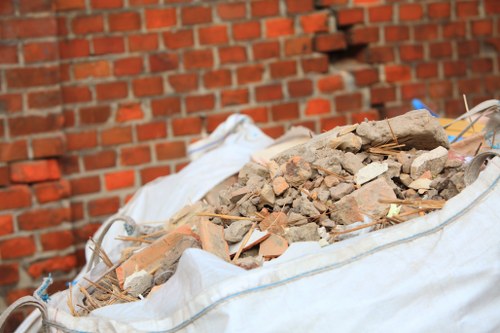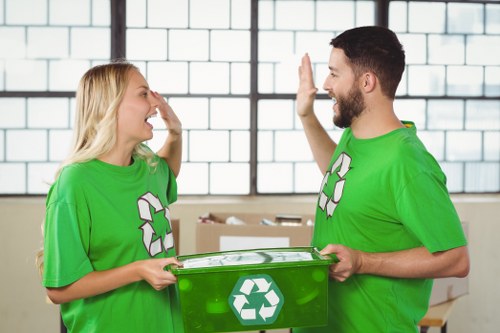Builders Waste Clearance in Staines: Efficient and Environmentally Responsible Solutions

When undertaking any construction or renovation project in Staines, managing the resulting waste is a critical aspect that cannot be overlooked. Effective builders waste clearance ensures that your project runs smoothly, adheres to local regulations, and maintains a clean and safe environment.
Staines, known for its blend of modern developments and historical sites, faces unique challenges when it comes to waste management. Builders waste clearance in this area requires specialized knowledge and efficient processes to handle the diverse types of materials generated during construction.
Choosing the right waste clearance service can significantly impact your project's timeline, budget, and environmental footprint. In this comprehensive guide, we delve into the essentials of builders waste clearance in Staines, providing you with the insights needed to make informed decisions.
The Importance of Builders Waste Clearance

Builders waste clearance is not merely about removing debris from a construction site; it's a vital component that contributes to the overall success of any building project. Proper waste management minimizes the risk of accidents, reduces environmental impact, and ensures compliance with local laws and regulations.
Neglecting waste clearance can lead to numerous issues, including site contamination, health hazards for workers and nearby residents, and potential legal consequences. Therefore, implementing an efficient waste clearance strategy is essential for maintaining project integrity and community goodwill.
Furthermore, sustainable waste clearance practices can enhance your company's reputation, showcasing a commitment to environmental responsibility. This can be a significant competitive advantage in today's eco-conscious market.
Types of Builders Waste

The construction process generates various types of waste, each requiring specific handling and disposal methods. Understanding these types is crucial for effective waste clearance.
1. Demolition Waste
Includes materials such as concrete, metal, wood, and masonry. Proper segregation and recycling of these materials can significantly reduce disposal costs and environmental impact.
2. Construction Debris
Consists of excess building materials like plasterboard, insulation, and packaging materials. Effective management ensures these items are recycled or disposed of responsibly.
3. Hazardous Waste
Includes substances like asbestos, lead paint, and certain chemicals. These require specialized handling and disposal to prevent environmental contamination and health risks.
- Concrete and Masonry
- Wood and Timber
- Plastics and Metals
- Hazardous Materials
Steps in the Builders Waste Clearance Process

An organized approach to waste clearance involves several key steps to ensure efficiency and compliance.
1. Waste Assessment
Evaluating the types and quantities of waste generated helps in planning the clearance process effectively.
2. Segregation and Sorting
Separating recyclable materials from non-recyclable ones minimizes landfill usage and promotes recycling initiatives.
3. Transportation
Using appropriate vehicles to transport waste to designated disposal or recycling facilities is essential for safety and compliance.
- Assessment
- Segregation
- Transportation
- Disposal/Recycling
Choosing the Right Waste Clearance Service

Selecting a reliable and experienced waste clearance service is paramount for the success of your construction project in Staines.
Factors to Consider
When evaluating potential service providers, consider the following factors:
- Experience and Expertise
- Compliance with Local Regulations
- Environmental Responsibility
- Pricing and Transparency
- Customer Reviews and Reputation
Benefits of Professional Services
Professional waste clearance services offer numerous advantages, including time savings, cost-effectiveness, and peace of mind knowing that waste is managed responsibly.
Time Efficiency
Experienced services can execute waste clearance swiftly, keeping your project on schedule.
Cost-Effectiveness
Proper waste management reduces the risk of unexpected costs associated with fines or delays.
Environmental Impact of Builders Waste Clearance
Environmental sustainability is a critical consideration in modern construction practices. Effective builders waste clearance contributes to reducing the carbon footprint and conserving natural resources.
Recycling and Reuse
Many construction materials can be recycled or repurposed, minimizing the demand for new resources and reducing landfill waste.
Compliance with Environmental Regulations
Adhering to environmental guidelines ensures that your construction project does not negatively affect the surrounding ecosystem.
Local Regulations in Staines
Staines has specific regulations governing waste disposal and recycling. Partnering with a local waste clearance service ensures compliance with these laws, avoiding potential penalties.
- Recycling Initiatives
- Waste Reduction Strategies
- Regulatory Compliance
Cost Considerations
Budgeting for builders waste clearance is an essential aspect of project financial planning. Understanding the factors that influence costs can help you make informed decisions.
Factors Affecting Costs
The cost of waste clearance can vary based on several factors:
- Volume and Type of Waste
- Frequency of Clearance
- Accessibility of the Site
- Special Handling Requirements
Cost-Saving Tips
Implementing strategic measures can help reduce waste clearance expenses:
- Efficient Waste Segregation
- Partnering with Local Recyclers
- Scheduling Regular Clearance
- Minimizing Waste Generation
Negotiating Contracts
Engaging in transparent negotiations with waste clearance providers can lead to more favorable terms and cost savings.
Regulatory Compliance and Legal Requirements
Compliance with local regulations and legal requirements is non-negotiable in builders waste clearance. Failure to adhere can result in fines, project delays, and reputational damage.
Key Regulations in Staines
Staines enforces strict guidelines on waste disposal, recycling mandates, and environmental protection measures. Ensuring your waste clearance service is well-versed in these regulations is crucial.
Permits and Documentation
Obtaining necessary permits and maintaining proper documentation for waste disposal activities ensures transparency and accountability.
- Understanding Local Laws
- Maintaining Accurate Records
- Ensuring Proper Disposal Methods
Penalties for Non-Compliance
Non-compliance can lead to significant penalties, including hefty fines and project shutdowns. Partnering with a compliant waste clearance service mitigates these risks.
Maintaining legal compliance is essential for the smooth operation and success of your construction project.Technological Advancements in Waste Clearance
The waste management industry is evolving with technological advancements that enhance efficiency and sustainability.
Automated Sorting Systems
Modern sorting technologies facilitate the efficient segregation of waste, improving recycling rates and reducing manual labor.
Tracking and Reporting Software
Advanced software solutions enable real-time tracking of waste streams, ensuring transparency and compliance with regulatory standards.
Eco-Friendly Disposal Methods
Innovative disposal techniques minimize environmental impact, supporting greener construction practices.
- Automated Sorting
- Real-Time Tracking
- Green Disposal Methods
Benefits of Technology Integration
Integrating technology into waste clearance processes offers numerous benefits, including enhanced accuracy, reduced costs, and improved environmental outcomes.
Case Studies: Successful Waste Clearance Projects in Staines
Examining successful builders waste clearance projects in Staines provides valuable insights into best practices and effective strategies.
Project A: Residential Development
A large-scale residential project effectively managed waste clearance by implementing robust segregation and recycling protocols, resulting in significant cost savings and environmental benefits.
Project B: Commercial Construction
A commercial building project partnered with a local waste clearance service that utilized advanced tracking technology, ensuring compliance and timely disposal of construction debris.
Project C: Heritage Site Renovation
Renovating a historical site in Staines required specialized handling of hazardous materials. The waste clearance service employed industry best practices to safely manage and dispose of all waste, preserving the site's integrity.
- Residential Development
- Commercial Construction
- Heritage Site Renovation
Lessons Learned
These projects highlight the importance of planning, collaboration with experienced waste clearance services, and adherence to environmental and regulatory standards.
Future Trends in Builders Waste Clearance
The builders waste clearance industry is poised for significant advancements, driven by sustainability initiatives and technological innovations.
Increased Recycling Capacity
Future trends indicate a surge in recycling capabilities, enabling the handling of a broader range of construction materials sustainably.
Adoption of Circular Economy Principles
Embracing circular economy models promotes the reuse and recycling of materials, reducing waste and fostering sustainable construction practices.
Integration of IoT and AI
Internet of Things (IoT) and Artificial Intelligence (AI) are set to revolutionize waste management, offering smart solutions for waste tracking, sorting, and optimization.
- Recycling Innovations
- Circular Economy Models
- Smart Waste Management
Preparing for the Future
Staying abreast of these trends allows builders and waste clearance services to adopt innovative practices, ensuring sustainability and efficiency in waste management.
Conclusion
Effective builders waste clearance in Staines is essential for the success and sustainability of construction projects. By understanding the types of waste, following a structured clearance process, selecting the right service provider, and embracing environmental responsibilities, builders can significantly enhance their project outcomes.
As the industry evolves, staying informed about technological advancements and future trends will further optimize waste management practices, promoting a greener and more efficient construction landscape in Staines.
Don’t let waste clearance be an afterthought in your construction project. Contact us today to ensure your builders waste clearance is handled professionally and responsibly.
Frequently Asked Questions (FAQ)
1. What is builders waste clearance?
Builders waste clearance involves the removal and disposal of waste materials generated during construction or renovation projects. It includes the management of debris, recyclable materials, and hazardous substances.
2. Why is waste clearance important in construction?
Proper waste clearance ensures a safe and clean construction site, minimizes environmental impact, and ensures compliance with local regulations.
3. How do I choose a waste clearance service in Staines?
Consider factors such as experience, compliance with local laws, environmental responsibility, customer reviews, and cost when selecting a waste clearance service.
4. Can construction waste be recycled?
Yes, many construction materials like concrete, metal, wood, and plastics can be recycled or repurposed, reducing the need for landfill disposal.
5. What are the costs associated with builders waste clearance?
The costs depend on factors like the volume and type of waste, frequency of clearance, site accessibility, and any special handling requirements.
Ready to streamline your construction project with expert builders waste clearance? Book your service now and ensure a clean, compliant, and efficient site.